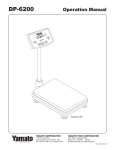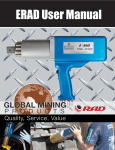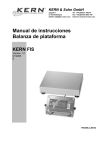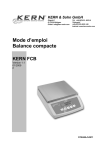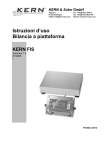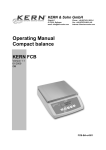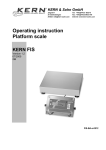Download Yamato PPC-200W Specifications
Transcript
PPC-200(W) Operation Manual PPC-200W: WASHDOWN PPC-200: SPLASH-PROOF Version 5.00 YAMATO CORPORATION 1775 S. Murray Blvd. Colorado Springs, CO 80916 USA Tel (719) 591-1500 Fax (719) 591-1045 YAMATO TECH CORPORATION #112-19425 Langley By-Pass Surrey, B.C. V3S 6K1 Canada Tel (604) 533-2338 Fax (604) 533-0827 YCO-1047-03-13 PPC-200(W) Operation Manual SAFETY INSTRUCTIONS Before using the scale, carefully read, understand, and follow the “Safety Instructions” described in this manual. Observe the advice given in the “Operations” section to ensure proper operation. Keep this operation manual handy for reference. 1) DO NOT SHOCK LOAD the scale, Never step on or sit on the scale. Not only will the scale be damaged, but you may also be injured. 2) DO NOT TWIST platform this will damage the scale. 3) DO NOT APPLY DIRECT WATER SPRAY to underside of scale!! 4) Do not operate the scale if there is smoke or a burnt smell coming from the scale. Remove the batteries or unplug the AC adaptor immediately. After making sure that there is no danger, consult your dealer. Never try to repair the scale by yourself. 5) This scale is not an explosion‑proof model. Do not use the scale in an atmosphere containing flammable gases or explosive fumes. A fire or an explosion can result. 6) Place the item to be weighed in the center of the platform. Items placed on the edge of the platform may fall off and cause injury. 7) When weighing a heavy, large or unbalanced item, make sure the item is stable on the platform, otherwise, an accident may occur. 8) When carrying or moving the scale, be sure to hold it by the bottom of the base with both hands. If you hold it by the platform, the platform or the platform support may become detached causing the scale to fall. This will damage the scale. The platform is designed for easy removal and clean‑up. 9) Do not insert your finger into the gap or holes in the scale. You may be injured. 10)The PPC-200(W) uses a liquid crystal display. If the LCD breaks and the liquid leaks from the LCD, do not touch it with your fingers. The liquid is toxic if ingested. Be especially careful around small children. To prevent damage to the scale 1) Do not push the indicator or keys with sharp objects. They may break or puncture the switch membrane panel. 2) Use the specified power supply and choose a suitable environment. If you do not, the weight readings may be inaccurate and the scale may be damaged. 3) The scale is a sensitive weighing instrument, avoid physical shocks. If you drop something on the scale, step on the platform, or drop it, the scale may be damaged and lose accuracy. 4) If the scale becomes dirty, wipe it with a soft cloth. For stubborn stains, apply a little neutral detergent and then wipe the scale with a dry cloth. Do not use thinner, benzene, hot water, or chemical agents, all of which can cause deformation, discoloration, or deterioration of the scale. 5) Never remove the case. The fine adjustment section may be damaged and you may be injured by sharp edges on the internal parts. 6) Do not place the scale upside down on the scale platform. 7) When the low battery indicator appears, replace all six of the batteries. When installing the batteries, install them according to the polarity markings in the case (+, ‑). If the scale will not be used for a long period, remove the batteries. To keep the scale working efficiently 1) Place the scale on a flat stable surface that will support the scale and the load. 2) Do not place the scale in an area exposed to direct sunlight or to wind currents from an air conditioner, otherwise, the weights will not be accurate. 3) Do not place the scale near machines that create vibrations or electromagnetic disturbance, such as microwave ovens, portable phones, or large motors. This will affect the accuracy. 4) The operating temperature range is from –5°C to +35°C (23°F to 95°F). Do not subject the scale to sudden temperature changes; allow the scale to adjust to the new temperature before use. 5) If the scale is sealed, do not break the seal. If you break the seal, the scale will not be considered legal for trade. In this case, contact your dealer. 6) Do not disassemble or modify the scale, you will void the warranty. Modified scales will not be legal for trade. 7) The PPC-200 is not a washdown scale, it is splash-proof. Do not use a water sprayer on the PPC-200 and do not use it in an extremely humid or dusty environment. 8) The PPC-220W is a washdown scale, but is not a submersible scale. Do not place the PPC-200W in water higher than the bottom of the housing. Do not spray water up into the underside of the PPC-200W. YCO-1047-03-13 PPC-200(W) Operation Manual Table of Contents I. Name and Function of Parts 1 II. Specifications 1 III. Directions for Use A. Installing Batteries or AC Adaptor B. Levelling the Scale C. Turning the Scale On and Off D. Checking the Battery Level E. Zero the Display F. Switching Between LB and KG G. Setting the Over/Under Indicator H. Weighing 1. Using the Over/Under Indicator 2. Gross Weighing 3. Net Weighing 4. Batching I. CAL Indicator 2 2 2 2 2 2 2 3 4 4 4 5 5 6 IV. Entering User Parameter Mode 6 V. 8 Optional Analog Meter VI. Troubleshooting and Error Messages 10 VII. User Parameter 11 YCO-1047-03-13 PPC-200(W) Operation Manual I Name and Function of Parts Fig. 1: Front side of the scale 1) 2) 3) 4) 5) ON/ZERO Key OFF Key TARE Key NET/GROSS Key Unit selection 6) 7) 8) 9) 10) 11) 12) 13) 14) 15) 16) LOW BATTERY Indicator Spirit level device CENTER ZERO Indicator STABLE Indicator MODE Indicator NET WEIGHT Indicator GROSS WEIGHT Indicator CAL Indicator Battery Cover Outlet of AC adaptor cable Levelling Legs Fig. 2: Bottom of the scale Turns the power on, and zeroes the display. Turns the power off. Tares off the weight on the scale platform. Toggles between gross and net weights. Press both keys simultaneously to toggle between pound and kilogram indications. Time to replace batteries. Used to level scale. Indicates scale is at gorss zero. Indicates that weight on the scale is stabilized. Indicates scale is in setup mode and weighing is not allowed. Shows scale is in net mode. Shows scale is in gross mode. Shows scale is not sealed for legal for trade operation. Tighten securely to maintain washdown seal. Use of an AC adapter voids washdown seal. Rotate to level the scale. II Specifications Weighing system: Platform: Weight display: Type: Character size, etc.: Optional equipment: Power supply: Consumption: Battery life: Operating temperature: Operating humidity: Waterproof classification: Strain‑gauge load cell 9” x 9” (230 x 230 mm), stainless steel Single face display 7 segment LCD 0.5” (12 mm) (W) x 0.9” (23 mm) (H), 5 digits Batteries, AC adaptor, Analog limit meter * 6 “D” size batteries or AC adaptor* 0.12 W (max.) 1000 hours of continuous use (when using alkaline batteries) 14°F to 104°F (‑10°C to 40°C) 25% to 85% RH PPC-200W complies with JIS class 5 standard (drip-proof V type) PPC-200 complies with JIS class 2 standard (drip-proof II type) * The scales is NOT washdown if it has been modified for the analog meter or if the AC jack seal has been removed. 1 YCO-1047-03-13 PPC-200(W) Operation Manual III Directions for Use III.A Installing Batteries or AC adaptor Remove the stainless steel platform. Gently and carefully turn the scale on it's side. Ensure the surface around the battery cover is dry. Do not allow water to enter the battery compartment. Turn the battery cover thumbscrew counterclockwise until it comes free. Swing the cover open. Install the batteries according to the polarity markings. If you reverse the polarities of the batteries, the scale will be damaged. Swing the battery cover into place and insert the thumbscrew. Tighten the thumbsrew securely. If the battery cover is loose, the washdown seal will leak. Use only the AC adaptor specified for use with the scale. Using the wrong adaptor can damage the scale. Remove the battery cover and the batteries, if installed. Replace the battery cover. Remove the washdown plug from the jack. Insert the adaptor plug securely into the jack. Do not washdown the scale if an AC adaptor is in use or if the washdown plug has been removed from the AC jack. III.B Leveling the Scale Place the scale on a flat and level surface. If the scale is not level, the readings may not be accurate. You can check whether the scale is level by using the bubble level device positioned on the left front surface of the scale. Adjust the feet by turning them in or out to lower or raise the corner of the scale the foot is on. III.C Turning the Scale On and Off Remove everything from the platform surface and press the key. The display will briefly flash all the LCDs. After approximately 5 seconds, the display will stop flashing and automatically set to zero. Press the key. The display will go off. Under battery operation, the power will be shut off auto- matically (AutoOff function) after about 15 minutes of non‑use, even if you don’t press the key. III.D Checking the Battery Level Turn the scale on and push the key while the display is flashing. The remaining battery life will be displayed. The more “o” you see, the more life there is left in the batteries. After a few seconds, the scale will go to weighing mode. III.E Zero the Display The scale will zero automatically when turned on. If a value is displayed when the platform is empty, push the key to zero the display. The maximum zero range during power up is approximately ± 1.9% of the scale capacity. III.F Switching Between LB and KG To switch between LB and KG, press and hold the key and press the 2 key. YCO-1047-03-13 PPC-200(W) Operation Manual III Directions for Use III.G Setting the Over/Under Indicator 1) Place the scale in normal weighing mode. 2) Press and hold the ners) key and push the key. (Yellow Cor- 3) Press the key to select the digit you want to change. The underscore will advance to the right. 4) Press the up and down arrows to select the desired value. 5) Repeat steps 3 and 4 until all digits are set. All values below this setpoint will be indicated as under. 6) Press and hold the key and push the key (Yellow Corners). This saves the lower limit and moves to the upper limit. 7) Press the key to select the digit you want to change. 8) Press the up and down arrows to select the desired value. 9) Repeat steps 7 and 8 until all digits are set. All values above this setpoint will be indicated as over. 10)Press and hold the key and push the key (Yellow Corners). This saves the upper limit and returns you to weighing mode. Note: See page 6 for optional Analog Meter operation. 3 YCO-1047-03-13 PPC-200(W) Operation Manual III Directions for Use III.H Weighing III.H.1 Using the Under/Over Indicator 1) Begin with no load on the scale, the display reading zero, and the center zero and stable indicators lit. The small up and down arrowheads on the right side of the display indicate that the over and under setpoints, respectively, have been set. 2) Place the item(s) to be weighed on the scale platform. If the item weighs less than the under setpoint, the large under arrow will appear. 3) If the item weighs from the lower setpoint to the upper setpoint, inclusive, the accept bullseye will appear. 4) If the item weighs more than the upper setpoint, the large over arrow will appear. III.H.2 Gross Weighing 1) Begin with no load on the scale, the display reading zero, and the center zero and stable indicators lit. 2) Place the item(s) to weighed on the scale platform. The weight displayed will be the gross weight. 4 YCO-1047-03-13 PPC-200(W) Operation Manual III Directions for Use III.H Weighing III.H.3 Net Weighing 1) Begin with no load on the scale, the display reading zero, and the center zero and stable indicators lit. 2) Place an empty container on the scale platform and press the key. The weight of the container will be deducted automatically, the display will read zero and the net indicator will light. 3) Place the item(s) to be weighed in the container. The weight displayed will be the net weight. 4) To display the gross weight, press the key. The gross indicator will light and the weight displayed will be the gross weight of the item(s) and the container. Press the to the net weight. key again to return 5) To return to gross weighing mode, remove all items from the scale platform and press the key. III.H.4Batching 1) Begin with no load on the scale, the display reading zero, and the center zero and stable indicators lit. 2) Place an empty container on the scale platform and press the key. The weight of the container will be deducted automatically, the display will read zero and the net indicator will light. 3) Place the first item in the container until the desired weight is reached. 4) Press the key and the display will return to zero. Place the next item in the container until the desired weight is reached. 5 YCO-1047-03-13 PPC-200(W) Operation Manual III Directions for Use III.H Weighing III.H.4 Batching (continued) 5) Continue in this manner until all items to be batched have been weighed. Do not allow the gross weight on the scale platform to exceed the capacity of the scale. 6) Remove all items from the scale platform and press the III.I key. CAL Indicator If the CAL indicator is lit, the PPC-200W has not been configured to be sealed for legal for trade use. System parameter 40 must be set to 003 for all legal for trade applications. For instructions on changing the system paramenters, please see Section IV Changing the Scale Setup in the PPC200W Technical Manual. IVEntering User Parameter Mode If the PPC-200W is configured for legal for trade use (system parameter 40 set to 003, CAL indicator is off), then keypad entry to user parameter mode will be disabled. When the PPC-200W is configured for legal for trade use, then entry to all parameter setting modes requires the scale to be opened and the test jumpers to be shorted to enter Test Mode. System parameter 40 must be set to 000 or 002 to enable keypad entry to user parameter mode. This will also activate the CAL annunciator, indicating that the scale is not properly configured for legal for trade operation. For more information on setting system parameters and entering Test Mode, please see the PPC-200W Technical Manual. 1. Turn scale on. Press and to enter User Parameter Mode. The scale will indicate a keyword followed by it’s value. 2. To select the desired keyword, use the keys as follows: - increase keyword by one + - decrease keyword by one Keyword Parameter Value Note: Use the User Parameter List in Section VII to locate the function to be changed and it’s standard value. Example: To select lb/kg priority at power on press nine times. 6 YCO-1047-03-13 PPC-200(W) Operation Manual IVEntering User Parameter Mode 3. To change a parameter value, use the keys as follows: - increase value by one + - decrease value by one + - increase value by ten - decrease value by ten 4.Press to save changes and press parameter. to exit User 7 YCO-1047-03-13 PPC-200(W) Operation Manual V Optional Analog Meter * * * WARNING * * * The PPC-200W is NOT WASHDOWN if the analog meter has been installed! Damage will result to the scale and meter if an attempt is made to washdown the scale after it has been modified for the analog meter. NOTICE The analog meter option is NOT LEGAL FOR TRADE. The optional analog meter has three programmable over and under registers labelled A, B and C. They are selected with the , ER UND ACCEPT OVE R and keys on the meter face. Pressing one of these keys once will cause the LED display to flash the under and over setpoints for that key. The meter must be calibrated before it can be set. Both procedures are detailed below. Calibrating the Analog Meter 1) Press and hold the key 2-3 seconds. The display will read Adj for adjust and the indicator will move to the under range. 2) Use the and keys to align the indicator with the low end of the under range. 3) Press the ER UND ACCEPT OVE R key. The indicator will move to the over range. ER UND ACCEPT OVE R 4) Use the and keys to align the indicator with the high end of the over range. 5) Press the key to save the calibration and to return to normal weighing mode. 8 YCO-1047-03-13 PPC-200(W) Operation Manual V Optional Analog Meter Setting the Analog Meter 1) Press and hold the key for 2-3 seconds. The display will show the current under setpoint. 2) Press the key to select the digit you want to change. The underscore will move to the right. 3) Press the or keys to set the desired value. 4) Repeat steps 2 and 3 until the entire number is set. 5) Press the key again to save the displayed under setpoint and to display the current over setpoint. 6) Press the key to select the digit you want to change. 7) Press the or keys to set the desired value. 8) Repeat steps 6 and 7 until the entire number is set. 9) Press the key to save the displayed upper setpoint and to return to normal weighing mode. This sets the register A setpoints. To set the register B or register C setpoints, begin by holding the or key in step 1. 9 YCO-1047-03-13 PPC-200(W) Operation Manual VITroubleshooting and Error Messages The scale can check various functions automatically. When a problem is detected, the following messages will be displayed. If you take the steps described below but the problem is not fixed, the scale needs to be serviced by a qualified scale technician. 1) The batteries are running low. When the batteries are running low, this indicator will come on. Replace all of the batteries with new ones. 2) The batteries are low. When the batteries are too low, this indicator will be displayed. The batteries must be replaced to use the scale. 3) The weight out of range. When the weighed value is 6 or more divisions heavier than the scale’s capacity this message will be displayed. When the weighed value is 6 or more divisions below zero, this message will be displayed. It is usually displayed when the platform is removed or has something wedged under it. 4) Initial error on startup. When the initial weight is heavier than the permissible zeroing range and the key is pressed, this message will be dis- played. Remove whatever is on the platform and press the key again. When the initial weight is lighter than the permissive zeroing range and the key is pressed, this message will be displayed. Install the platform or remove any objects under the platform, and press the key again. 5) The weighing sensor error. When the weight detecting section has a problem, this message will be displayed. Turn off the power. Then turn the power on again. 6) The electronic circuitry error. When the electronic circuit has a problem, this message may be displayed. Turn off the power. Then turn the power on again. 7) The electromagnetic disturbance error. This Indicator is occasionally displayed due to strong static electricity and/or electro-magnetic disturbance. Turn off the power. Then turn the power on again. 10 YCO-1047-03-13 PPC-200(W) VII Operation Manual User Parameter Key Word 01 Std Value 015 Function Auto-off timer 02 000 Display hold timer 03 001 Communication 04 000 Communication data 05 000 Communication speed 06 000 Character length 07 002 Parity 08 001 Stop bit length 09 001 Default mode Description 000 Disables auto-off. 001~240 Number of minutes unused to activate auto-off. 000 No display hold for changes less than four divisions. 001~030 Display hold duration, in seconds, for changes less than four divisions. 031 No display hold. 000 No serial interface. 001 Specified commands acceptable. 002 Sends zero detection. 003 Sends motion detection. 004 Sends continuously. 000 Net weight (1 batch) 001 Net weight, tare weight, gross weight (1 batch) 002 Net weight, tare weight, gross weight (3 batches) 003 Display content (1 batch) 004 Serial printer format (1 batch) 000 9600 bps 001 600 bps 002 1200 bps 003 2400 bps 004 4800 bps 005 9600 bps 006 19200 bps 007 38400 bps 000 8 bits 001 7 bits 000 Non 001 Odd 002 Even 000 1 bit 001 2 bits 000 kg 001 lb/oz NOTICE The RS-232 serial interface option is only available and legal-for-trade on CPU versions 4.02 and above. See section 4 (Changing the Scale Setup - Test Mode) of the PPC-200(W) Technical Manual for instructions on how to enter test mode and view the CPU version. See the PPC RS232 Operation Manual for more information on using the RS-232 serial interface option. 11 YCO-1047-03-13
















